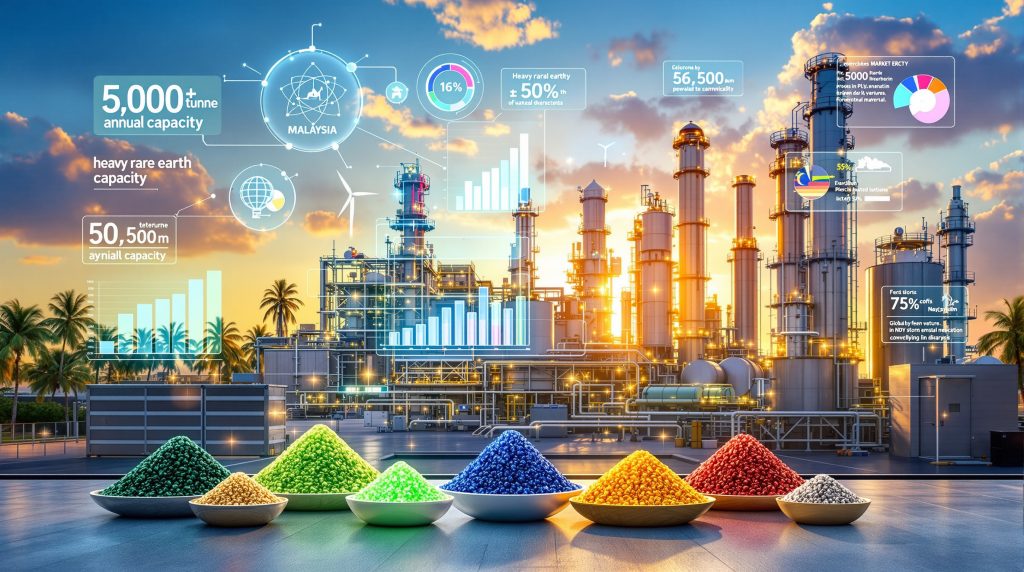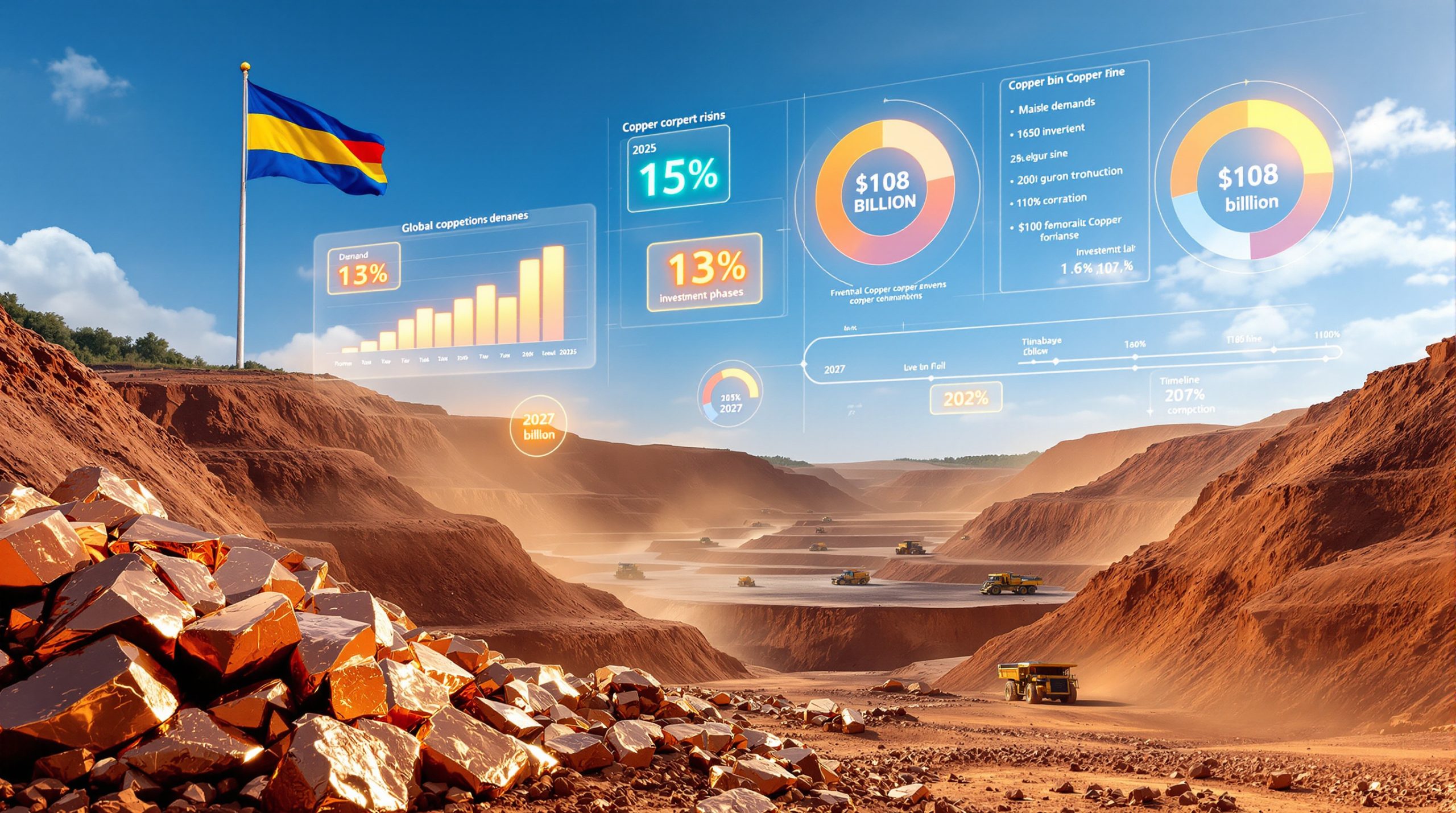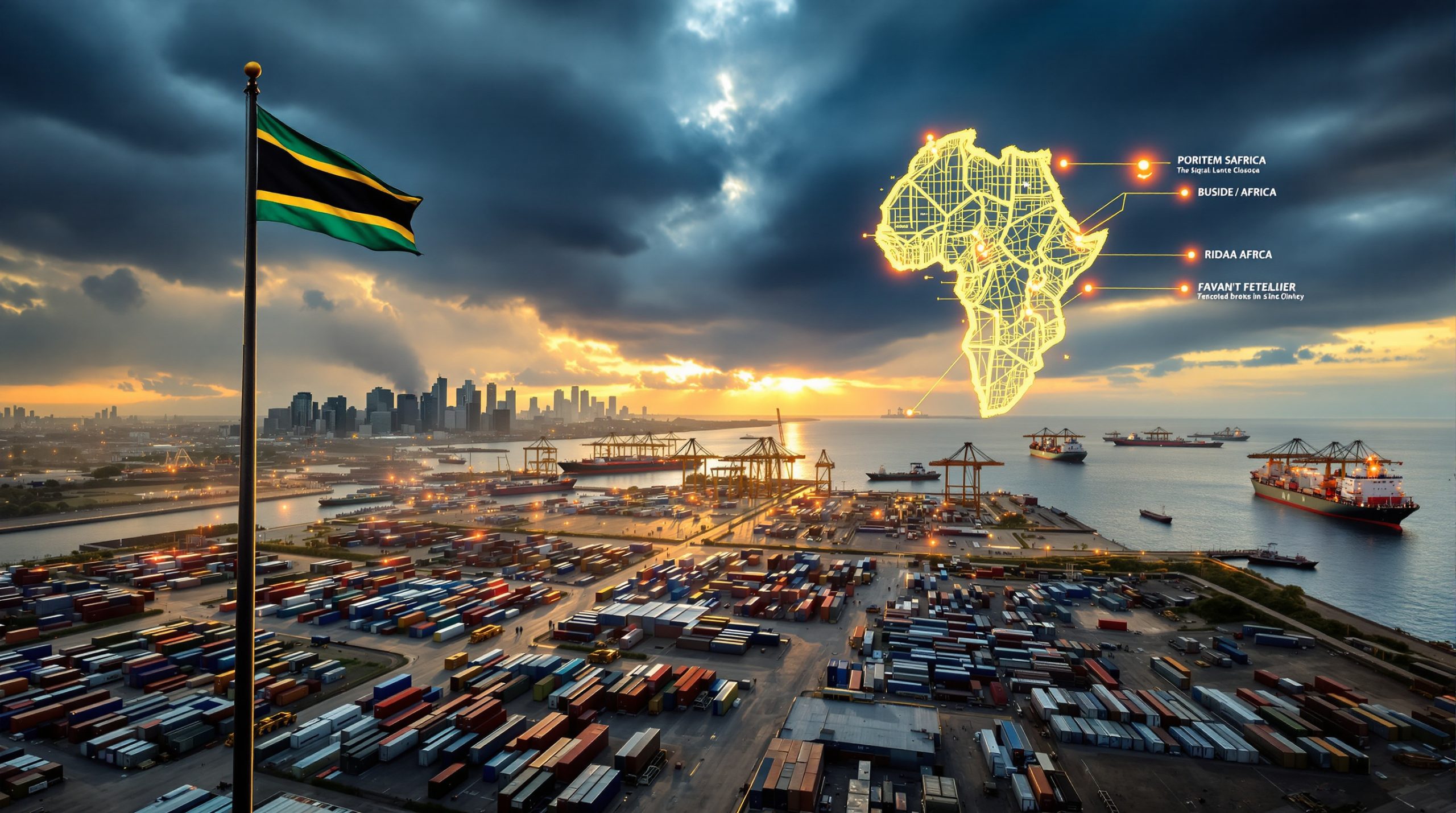Understanding Malaysia's Strategic Position in Global Rare Earth Processing
Malaysia's emergence as a critical processing hub for heavy rare earths represents a fundamental shift in global supply chain dynamics. The country's establishment of an expanded heavy rare earths separation facility in Malaysia marks a significant milestone in reducing global dependency on Chinese rare earth processing capabilities.
The newly announced facility expansion by Lynas Rare Earths will process up to 5,000 metric tons per year of heavy rare earth feedstock, representing a substantial increase from current Malaysian operations that focus primarily on dysprosium and terbium oxide production. This expansion positions Malaysia as one of the few countries outside China with significant heavy rare earth processing capabilities.
According to the U.S. Geological Survey's Mineral Commodity Summaries, China currently dominates global rare earth processing, handling approximately 70-85% of global rare earth elements annually. Malaysia's expanded capacity, while representing only a fraction of China's total processing volume, provides critical supply chain diversification for technology manufacturers seeking reliable non-Chinese sources.
The facility's location at Lynas Malaysia in Gebeng leverages existing infrastructure that has operated since 2012, demonstrating established regulatory approval pathways and operational expertise. This foundation enables cost-effective expansion while minimising development risks associated with greenfield projects.
Malaysia's geographic positioning offers strategic advantages for rare earth processing operations. The country sits at the crossroads of major Asian technology manufacturing centres, providing efficient logistics access to semiconductor fabrication facilities in Taiwan and South Korea, electric vehicle manufacturing hubs throughout Southeast Asia, and renewable energy equipment producers across the region.
Why Heavy Rare Earths Command Premium Market Values
Heavy rare earth elements represent some of the world's most strategically critical materials, commanding significantly higher prices than their light rare earth counterparts due to geological scarcity and specialised applications in advanced manufacturing. These materials are essential components in the critical minerals energy transition, driving demand across renewable energy and electric vehicle sectors.
The expanded facility will initially process six heavy rare earth elements: samarium, gadolinium, dysprosium, terbium, yttrium, and lutetium. Future phases may include europium, holmium, ytterbium, and erbium, subject to commercial agreements that provide appropriate investment returns.
Critical Applications by Element:
- Dysprosium: Essential for permanent magnets in electric vehicle motors and wind turbine generators, where its heat resistance properties enable high-performance operation
- Terbium: Crucial for green phosphors in LED displays and energy-efficient lighting systems
- Yttrium: Required for laser crystals, medical imaging equipment, and advanced ceramics
- Gadolinium: Indispensable for MRI contrast agents and neutron absorption applications in nuclear technology
- Samarium: Used in precision motors, military guidance systems, and specialised magnetic applications
- Lutetium: Applied in positron emission tomography (PET) scan detectors and specialised research equipment
Market dynamics favour heavy rare earths due to their concentrated geological distribution. Unlike light rare earths, which occur in numerous deposits worldwide, heavy rare earths are found in economically viable quantities in relatively few locations. This scarcity creates supply bottlenecks that the Malaysian facility expansion directly addresses.
The pricing differential between heavy and light rare earths reflects this scarcity premium. Industry data indicates dysprosium oxide typically trades at prices 10-15 times higher than light rare earth oxides, while terbium commands even greater premiums due to its specialised applications and limited supply sources.
Global Processing Capacity Comparison and Market Context
The 5,000-tonne annual capacity of Malaysia's expanded facility represents a strategically significant addition to global non-Chinese heavy rare earth processing capabilities, though it remains modest compared to large Chinese operations. This development aligns with broader trends in mining industry evolution towards supply chain diversification.
| Processing Facility Type | Annual Capacity (Tonnes) | Geographic Region | Market Share |
|---|---|---|---|
| Malaysia Expanded Facility | 5,000 | Southeast Asia | Critical non-Chinese source |
| Large Chinese Facilities | 8,000-15,000 | China | Dominant market position |
| Other Non-Chinese Operations | <1,000 | Various | Limited capacity |
| Total Chinese Capacity | 150,000+ | China | 70-85% global market |
The facility's capacity becomes more significant when viewed specifically within heavy rare earth processing rather than total rare earth separation. Non-Chinese heavy rare earth processing capacity remains extremely limited, making Malaysia's 5,000-tonne contribution a substantial percentage of available alternative supply.
China's processing dominance stems from decades of infrastructure development, regulatory frameworks favouring domestic processing, and integrated supply chains connecting mining operations with separation facilities. However, this concentration creates supply security risks for international technology manufacturers, particularly amid ongoing US-China trade war impact considerations affecting global supply chains.
The Malaysian expansion addresses specific market gaps in heavy rare earth availability. Current global demand for dysprosium exceeds 2,000 tonnes annually, while terbium demand approaches 400 tonnes per year. These figures continue growing as electric vehicle adoption accelerates and renewable energy deployment expands globally.
Investment Timeline and Strategic Implementation Phases
The $117 million investment follows a carefully structured implementation approach designed to optimise capital deployment while minimising market disruption. Lynas Rare Earths will self-fund the project using proceeds from their September 2025 equity raise, eliminating external financing dependencies.
Detailed Implementation Schedule:
Phase 1 – Initial Production (April 2026):
- First samarium production from Mt Weld feedstock begins
- Processing capacity focused on highest-demand elements
- Quality control systems and market validation
Phase 2 – Full Initial Suite (2027):
- Complete separation capabilities for six primary elements
- Processing capacity reaches full 5,000-tonne annual throughput
- Comprehensive product portfolio established
Phase 3 – Conditional Expansion (Post-2027):
- Additional elements (europium, holmium, ytterbium, erbium) subject to commercial agreements
- Capacity optimisation and efficiency improvements
- Market-driven expansion decisions
The phased approach reflects sophisticated project management recognising both technical complexity and market dynamics. Samarium production leads the schedule, likely due to established market demand and separation process maturity within Lynas' existing technical capabilities.
This timeline positions Malaysia to capture growing market opportunities in electric vehicle manufacturing and renewable energy deployment. The International Energy Agency projects global electric vehicle sales will reach 35 million units annually by 2030, creating substantial demand for heavy rare earth permanent magnets.
Investment Risk Factors:
- Feedstock supply consistency from Mt Weld operations
- Regulatory approval timelines for facility modifications
- Market demand volatility affecting pricing and volume requirements
- Technical challenges in separation process optimisation
- Competition from Chinese producers and potential pricing pressures
What Are Malaysia's Primary Feedstock Sources?
The facility's feedstock strategy combines proven reserves with emerging supply opportunities, creating a diversified input portfolio designed to ensure consistent production while reducing single-source dependency risks.
Primary Feedstock Source – Mt Weld Deposit:
The Mt Weld deposit in Western Australia serves as the primary feedstock source, containing approximately 20 million tonnes of mineral reserves with integrated light and heavy rare earth content. This deposit ranks among the world's highest-grade rare earth resources, enabling cost-effective processing while providing comprehensive element availability.
Mt Weld's geological characteristics offer several processing advantages. The deposit's carbonatite-hosted mineralisation provides cleaner separation processes compared to many rare earth deposits, reducing processing complexity and environmental impact. The integrated light and heavy rare earth content enables comprehensive product portfolio development without requiring multiple feedstock sources.
Secondary Feedstock Development – Malaysian Ionic Clay Deposits:
Malaysian ionic clay rare earth deposits represent an emerging feedstock opportunity currently under development. These deposits offer several potential advantages over traditional hard-rock mining operations:
- Lower environmental impact through reduced mining infrastructure requirements
- Simplified processing through leaching-based extraction methods
- Potential cost advantages once development reaches commercial scale
- Geographic proximity reducing transportation costs and logistics complexity
However, ionic clay deposit development timelines remain uncertain. The source material indicates these deposits are "to be developed" without specific production targets or completion schedules. This uncertainty represents a potential risk factor for long-term feedstock security planning.
Supply Chain Resilience Considerations:
The dual-source feedstock approach addresses several strategic vulnerabilities in rare earth supply chains. Single-source dependency creates operational risks through potential supply disruptions, price volatility, and regulatory complications. Diversified feedstock sourcing enables continued operations even if individual supply sources experience temporary constraints.
Regional feedstock development also reduces transportation costs and logistics complexity. Malaysian ionic clay processing would eliminate international shipping requirements while supporting local economic development initiatives.
Malaysia's Competitive Advantages in Global Rare Earth Processing
Malaysia's rare earth processing sector benefits from unique competitive positioning that combines technical expertise, regulatory stability, and strategic geographic location. These advantages create sustainable differentiation in the increasingly competitive global marketplace, particularly considering the rare earth upgrade breakthrough developments emerging globally.
Established Infrastructure and Operational Experience:
Lynas Malaysia's existing facility demonstrates proven operational capabilities in rare earth processing. The company currently produces separated dysprosium and terbium oxide, indicating established technical competence and market access. This operational foundation enables cost-effective expansion while minimising development risks associated with new facility construction.
The facility's location in Gebeng provides established infrastructure including power supply, water treatment facilities, transportation networks, and trained workforce availability. These existing resources reduce capital requirements for expansion while accelerating project implementation timelines.
Regulatory Framework and Government Support:
Malaysia maintains an established regulatory framework for rare earth processing operations, developed through years of operational experience with the Lynas facility. This regulatory environment provides predictable approval processes while ensuring environmental protection standards.
The Malaysian government has demonstrated consistent support for downstream value-added processing initiatives, recognising rare earth processing as a strategic industrial development opportunity. This support includes policy frameworks encouraging foreign investment in advanced manufacturing sectors.
Geographic and Market Access Advantages:
Malaysia's location provides optimal access to major Asian technology manufacturing centres. The country sits within efficient shipping distance of:
- Semiconductor manufacturing hubs: Taiwan, South Korea, Japan, Singapore
- Electric vehicle production centres: China, Thailand, Vietnam, Indonesia
- Renewable energy equipment manufacturers: Throughout Asia-Pacific region
- Electronics assembly facilities: Malaysia, Philippines, Thailand, Vietnam
This geographic positioning reduces logistics costs and delivery times compared to processing facilities located in other regions. Proximity to end-user markets creates competitive advantages in customer service and supply chain responsiveness.
Cost Structure Competitiveness:
Malaysian processing operations benefit from competitive cost structures including skilled labour availability at reasonable wage levels, reliable energy supply, and established industrial infrastructure. These factors enable cost-effective processing while maintaining international quality standards.
The facility expansion's $117 million investment for 5,000-tonne annual capacity represents approximately $23,400 per tonne of processing capability, indicating efficient capital deployment compared to typical rare earth processing facility costs.
Industries Positioned to Benefit from Enhanced Heavy Rare Earth Supply
The expanded Malaysian processing facility directly supports several high-growth industrial sectors currently experiencing supply constraints in critical heavy rare earth materials. This development particularly benefits sectors aligned with the defence critical materials strategy, ensuring secure access to essential resources.
Electric Vehicle Manufacturing Sector:
Electric vehicle production represents the largest growth driver for heavy rare earth demand. Each electric vehicle requires permanent magnet motors containing dysprosium and terbium for high-temperature operation and magnetic field stability. Industry analysis indicates typical EV permanent magnet motors require:
- 2-4 kg dysprosium per vehicle for heat resistance and magnetic stability
- 0.2-0.4 kg terbium per vehicle for enhanced magnetic properties
- 8-12 kg total rare earth content including light rare earth components
Global EV sales reached approximately 14 million units in 2023, with projections indicating growth to 35 million units annually by 2030 according to International Energy Agency forecasts. This growth trajectory creates substantial demand for Malaysian heavy rare earth production.
Wind Energy Infrastructure Development:
Modern wind turbines utilise permanent magnet generators requiring significant quantities of heavy rare earths for efficient electricity generation. The Global Wind Energy Council reports approximately 1,050 GW of cumulative global wind capacity as of 2023, with annual installations exceeding 150 GW.
Large offshore wind turbines can require:
- 200-600 kg dysprosium per turbine for generator magnets
- 30-100 kg terbium per turbine for magnetic field optimisation
- 1-3 tonnes total rare earth content per multi-megawatt turbine
Advanced Electronics and Defense Applications:
Defence and aerospace sectors represent premium markets for heavy rare earth elements due to performance requirements exceeding commercial applications. These sectors utilise:
- Yttrium: Laser systems, radar components, and precision guidance equipment
- Gadolinium: Neutron detection systems and specialised electronics shielding
- Lutetium: Advanced imaging systems and specialised research equipment
Defence applications typically involve smaller volumes but command premium pricing due to stringent quality requirements and security considerations.
Medical Equipment Manufacturing:
Medical imaging and diagnostic equipment represents a stable, growing market for specific heavy rare earth elements:
- Gadolinium: Essential for MRI contrast agents and medical imaging enhancement
- Yttrium: Required for specialised laser systems and medical isotope production
- Lutetium: Critical for PET scan detectors and advanced diagnostic equipment
The global medical imaging market continues expanding as healthcare access improves worldwide and aging populations require increased diagnostic services.
How Will This Impact Supply Chain Resilience?
Malaysia's expanded heavy rare earth processing capacity addresses critical vulnerabilities in global technology supply chains while providing enhanced market stability for strategic materials. This development significantly strengthens supply chain resilience beyond single-source dependency risks.
Risk Reduction Through Geographic Diversification:
The facility expansion reduces systemic risks associated with single-country supply chain dominance. Current heavy rare earth processing concentration in China creates potential disruption scenarios affecting:
- Trade policy changes impacting export availability
- Environmental regulations affecting production capacity
- Geopolitical tensions influencing supply security
- Natural disasters or operational incidents disrupting production
Malaysian processing capabilities provide alternative supply sources enabling continued production even during Chinese supply disruptions. This diversification creates more resilient supply chains for critical technology manufacturing.
Price Stability and Market Competition:
Increased non-Chinese processing capacity introduces competitive dynamics potentially moderating price volatility in heavy rare earth markets. Historical price data shows significant volatility in rare earth pricing, often correlated with Chinese production policy changes or export restrictions.
Alternative supply sources create competitive pressure reducing the ability of any single producer to manipulate pricing through supply restrictions. This competition benefits downstream manufacturers through:
- More predictable pricing enabling better cost planning
- Reduced price spike risks during supply constraints
- Improved negotiating leverage with multiple supplier options
- Enhanced supply security supporting long-term investment planning
Quality Assurance and Standards Compliance:
Malaysian processing operations adhere to international quality standards and environmental regulations, providing consistent product specifications required for advanced manufacturing applications. This quality assurance becomes particularly important for defence, aerospace, and medical applications requiring stringent material specifications.
International certification and quality systems enable global market acceptance while ensuring product traceability and consistency. These factors are increasingly important as supply chain transparency requirements expand across technology sectors.
Environmental Management and Regulatory Compliance
Heavy rare earth processing requires sophisticated environmental management systems addressing potential ecological impacts while ensuring sustainable operational practices. The expanded heavy rare earths separation facility in Malaysia operates under comprehensive environmental oversight frameworks.
Comprehensive Environmental Framework:
The Malaysian facility operates under stringent environmental oversight developed through years of rare earth processing experience. Key environmental management components include:
- Waste Treatment Systems: Advanced containment and treatment of process wastes
- Water Management: Recycling and purification systems minimising freshwater consumption
- Air Quality Control: Emission monitoring and control systems ensuring regulatory compliance
- Community Engagement: Transparent communication regarding environmental performance
Malaysian regulatory authorities maintain active oversight of rare earth processing operations, requiring regular environmental monitoring and public reporting. This regulatory framework ensures sustainable operations while maintaining community acceptance.
Sustainability Considerations:
Modern rare earth processing incorporates sustainability principles addressing long-term environmental stewardship:
- Energy Efficiency: Process optimisation reducing energy consumption per tonne processed
- Waste Minimisation: Advanced separation technologies reducing waste generation
- Resource Recovery: Recycling and reuse systems maximising material utilisation
- Ecological Protection: Habitat preservation and restoration initiatives
The facility's expansion incorporates current best practices in environmental management, potentially setting standards for future rare earth processing operations globally.
Critical Environmental Consideration: Rare earth processing generates radioactive materials requiring specialised handling and disposal systems. Malaysian regulatory frameworks address these requirements through comprehensive licensing and monitoring systems ensuring public safety and environmental protection.
Economic Development and Regional Impact Analysis
The facility expansion creates significant economic multiplier effects throughout Malaysia's industrial ecosystem, extending beyond direct employment to encompass supporting industries and regional development initiatives.
Direct Economic Contributions:
The $117 million investment represents substantial capital deployment creating immediate economic activity through:
- Construction employment during facility development phases
- Specialised technical positions for operations and maintenance
- Management and administrative roles supporting expanded operations
- Research and development positions for process optimisation
Heavy rare earth processing requires highly skilled technical personnel including metallurgical engineers, chemical process specialists, and quality control technicians. These positions typically command premium salaries reflecting specialised expertise requirements.
Indirect Economic Benefits:
The facility's operations generate substantial indirect economic activity throughout regional supply chains:
- Supporting Service Industries: Maintenance, logistics, and professional services
- Supply Chain Partners: Equipment suppliers, chemical reagents, and specialised materials
- Transportation Services: Feedstock delivery and product distribution networks
- Financial Services: Banking, insurance, and specialised financing for operations
Technology Transfer and Industrial Development:
Advanced rare earth processing capabilities create knowledge spillovers benefiting Malaysia's broader industrial development:
- Technical Expertise: Training and development of specialised processing skills
- Research Capabilities: Laboratory facilities and testing equipment supporting broader industrial applications
- Supply Chain Development: Local supplier capability enhancement
- Innovation Ecosystem: Research partnerships and technology development initiatives
Export Revenue Generation:
Heavy rare earth oxides represent high-value manufactured products generating substantial export revenues. Based on current market pricing, the facility's 5,000-tonne annual capacity could generate:
- $200-400 million annual export revenue depending on product mix and market pricing
- Significant foreign exchange earnings supporting Malaysia's trade balance
- Value-added manufacturing rather than raw material exports
What Are the Future Expansion Opportunities?
The current expansion establishes foundation capabilities enabling future growth opportunities as global demand for heavy rare earths continues increasing across multiple industrial sectors.
Capacity Expansion Potential:
The facility's modular design principles enable future capacity additions subject to market demand and commercial viability assessments. Potential expansion opportunities include:
- Additional Separation Lines: Expanding processing capacity for existing elements
- Secondary Element Processing: Adding europium, holmium, ytterbium, and erbium separation capabilities
- Specialised Products: Ultra-high purity materials for advanced applications
- Recycling Capabilities: Processing end-of-life products containing rare earth elements
Downstream Manufacturing Integration:
Future development phases could incorporate downstream manufacturing capabilities creating higher value-added products:
- Permanent Magnet Manufacturing: Direct conversion of rare earth oxides into finished magnets
- Specialised Alloy Production: Custom alloys for specific industrial applications
- Component Manufacturing: Finished components for electronics and automotive sectors
Regional Hub Development:
Malaysia's processing capabilities position the country as a potential regional hub for rare earth research and development initiatives:
- Technical Centre of Excellence: Advanced processing research and optimisation
- Training and Education: Workforce development for regional rare earth industries
- Supply Chain Coordination: Integration with emerging Southeast Asian supply sources
- Standards Development: Leadership in environmental and quality standards
Market Integration Opportunities:
The facility's success enables broader integration with global rare earth value chains:
- Strategic Partnerships: Collaboration with technology manufacturers requiring secure supply sources
- Long-term Supply Agreements: Multi-year contracts providing operational stability
- Joint Ventures: Partnerships with mining companies developing new rare earth deposits
- Technology Licensing: Sharing processing expertise with other non-Chinese operations
Strategic Implications for Global Rare Earth Markets
Malaysia's expanded heavy rare earths separation facility in Malaysia represents more than capacity addition—it signifies a fundamental shift toward supply chain diversification and strategic resource security. The facility's development addresses critical vulnerabilities in global technology supply chains while establishing Malaysia as a key player in rare earth processing outside China.
The 5,000-tonne annual capacity, while modest compared to Chinese operations, provides essential supply security for international technology manufacturers. This capacity becomes particularly significant within heavy rare earth processing, where non-Chinese alternatives remain extremely limited.
The facility's $117 million investment demonstrates commercial viability for non-Chinese rare earth processing when supported by appropriate feedstock sources and market demand. The project's self-funding through equity raises indicates strong investor confidence in rare earth market fundamentals and Malaysia's processing capabilities.
Long-term Market Transformation:
This expansion contributes to broader trends reshaping global rare earth markets:
- Supply Chain Resilience: Reduced dependency on single-source suppliers
- Competitive Dynamics: Increased competition potentially moderating pricing volatility
- Technology Access: Secure access to critical materials for advanced manufacturing
- Strategic Security: Enhanced resource security for technology-dependent economies
The facility represents the beginning rather than the conclusion of Malaysia's rare earth processing development. As global demand continues growing across electric vehicles, renewable energy, and advanced technology sectors, Malaysia's established capabilities position the country for expanded roles in critical mineral processing.
Success factors for the facility include consistent feedstock availability from Mt Weld operations, continued development of Malaysian ionic clay deposits, and sustained global demand for heavy rare earth elements. These elements align favourably with current market trends and technological development patterns.
Investment and Development Implications:
The project demonstrates that strategic rare earth processing investments can achieve commercial success outside traditional Chinese-dominated markets. This success may encourage similar developments in other countries seeking supply chain diversification, potentially accelerating global rare earth processing capacity development.
For technology manufacturers, the facility provides critical supply chain optionality enabling reduced dependency on Chinese sources while maintaining access to essential materials. This diversification supports long-term investment planning and strategic development initiatives across multiple industrial sectors.
The expansion ultimately reflects evolving global awareness of critical mineral supply chain vulnerabilities and the strategic importance of processing capability diversification. Malaysia's success in this endeavour may serve as a model for other countries and regions seeking to develop domestic rare earth processing capabilities.
Disclaimer: This analysis is based on publicly available information and industry data current as of October 2025. Rare earth markets are subject to significant volatility, and future performance may differ from current projections. Investors should conduct independent research and consult with qualified advisors before making investment decisions related to rare earth companies or markets.
Looking to Capitalise on Critical Minerals Investment Opportunities?
Discovery Alert's proprietary Discovery IQ model delivers instant notifications on significant ASX mineral discoveries, including critical minerals essential for global supply chain diversification. Explore how major mineral discoveries have generated substantial returns for early investors, then begin your 30-day free trial today to position yourself ahead of the market.




